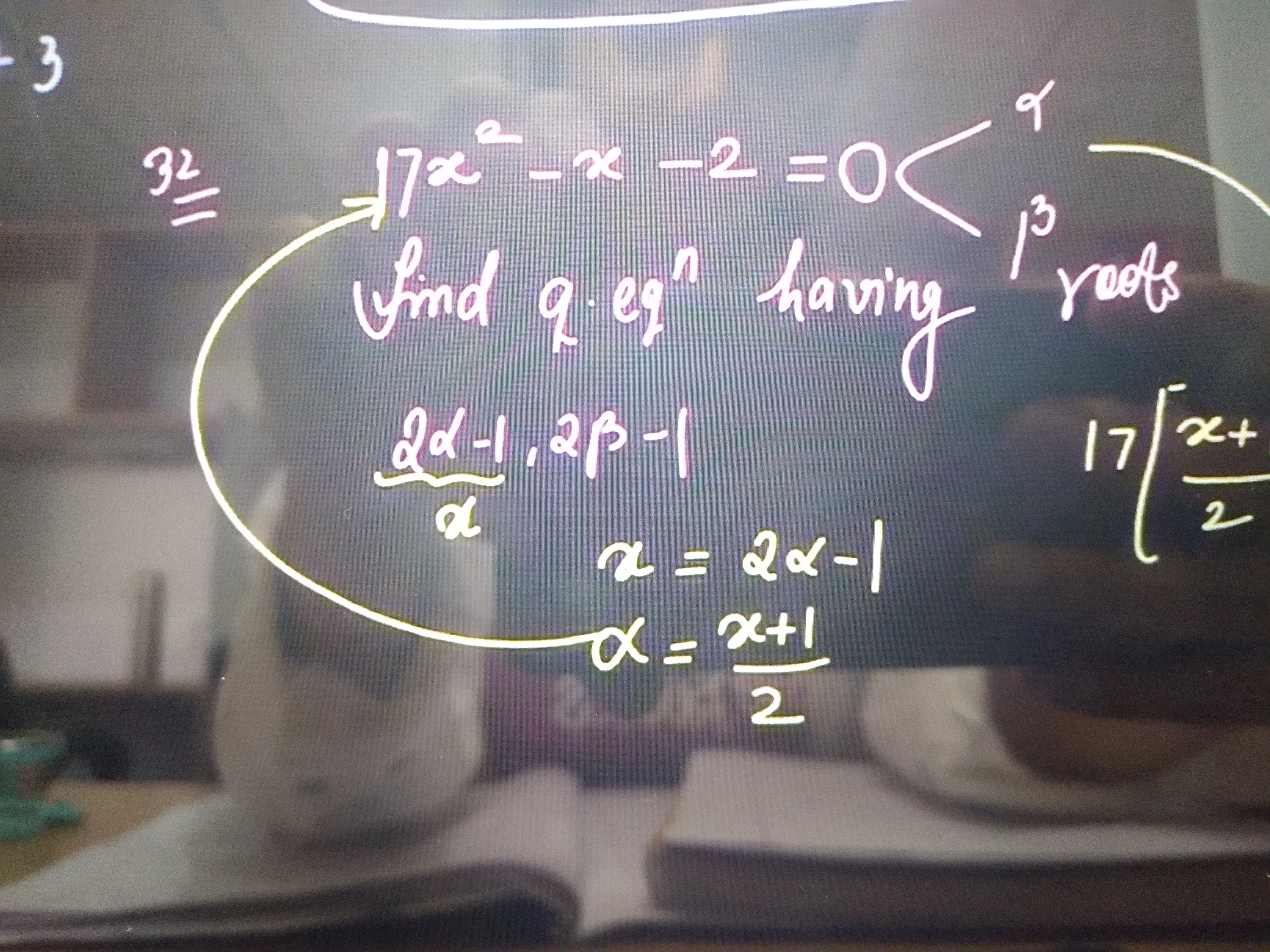Question
Question: 32 $17x^{2}-x-2=0$ find q.eq" having roots $\frac{2\alpha-1}{\alpha}$, $2\beta-1$...
32 17x2−x−2=0 find q.eq" having roots α2α−1, 2β−1

The final answer is 2y2−9y−7=0
Solution
Let the given quadratic equation be 17x2−x−2=0. The roots of this equation are α and β. From Vieta's formulas, we have: Sum of roots: α+β=−17−1=171 Product of roots: αβ=17−2
We need to find a quadratic equation with roots y1=α2α−1 and y2=2β−1. Let's simplify the first root: y1=α2α−1=α2α−α1=2−α1
To find the value of α1, we can use the original equation 17α2−α−2=0. Since α is a root, it satisfies the equation. Note that α=0 because 17(0)2−0−2=−2=0. Divide the equation by α: 17α−1−α2=0 Rearrange to solve for α1: α2=17α−1 α1=217α−1
Now substitute this back into the expression for y1: y1=2−217α−1=24−(17α−1)=24−17α+1=25−17α
So the new roots are y1=25−17α and y2=2β−1.
Let's compute the sum (S) and product (P) of these new roots. Sum: S=y1+y2=25−17α+(2β−1) S=25−17α+2(2β−1)=25−17α+4β−2=23−17α+4β
Product: P=y1y2=(25−17α)(2β−1) P=21[(5−17α)(2β−1)] P=21[10β−5−34αβ+17α] P=21[17α+10β−5−34αβ]
Substitute the values of α+β=171 and αβ=−172: P=21[17α+10β−5−34(−172)] P=21[17α+10β−5+4] P=21[17α+10β−1]
This approach leads to expressions that still depend on α and β. Let's try a different method.
Consider the transformation y=x2x−1. We want to find the equation for y when x is a root of 17x2−x−2=0. From y=x2x−1, we can express x in terms of y: yx=2x−1 1=2x−yx 1=x(2−y) x=2−y1
Substitute this into the original equation 17x2−x−2=0: 17(2−y1)2−(2−y1)−2=0 (2−y)217−2−y1−2=0
Multiply the entire equation by (2−y)2 to clear the denominators: 17−(2−y)−2(2−y)2=0 17−2+y−2(4−4y+y2)=0 15+y−8+8y−2y2=0 −2y2+9y+7=0
Multiply by -1 to make the leading coefficient positive: 2y2−9y−7=0
The roots of this equation are α2α−1 and β2β−1.
Now consider the second root y2=2β−1. Let z=2x−1. Then x=2z+1. Substitute this into 17x2−x−2=0: 17(2z+1)2−(2z+1)−2=0 174(z+1)2−2z+1−2=0 Multiply by 4: 17(z2+2z+1)−2(z+1)−8=0 17z2+34z+17−2z−2−8=0 17z2+32z+7=0 The roots of this equation are 2α−1 and 2β−1.
The problem asks for an equation with roots α2α−1 and 2β−1. Let's go back to the sum and product calculation with the correct root expressions. y1=α2α−1 and y2=2β−1.
Let's use the fact that 17α2−α−2=0. From this, 2=17α2−α. Substitute this into the numerator of y1: y1=α2α−(17α2−α)=α3α−17α2=3−17α.
So the new roots are y1=3−17α and y2=2β−1. Let's find the sum S and product P of these roots. S=y1+y2=(3−17α)+(2β−1)=2−17α+2β. P=y1y2=(3−17α)(2β−1)=6β−3−34αβ+17α.
Using α+β=1/17 and αβ=−2/17: S=2−17α+2(171−α)=2−17α+172−2α=2+172−19α=1734+2−19α=1736−19α. P=17α+6β−3−34αβ=17α+6(171−α)−3−34(−172) P=17α+176−6α−3+4=11α+176+1=11α+176+17=11α+1723.
This still depends on α. Let's re-examine the problem statement and the provided hint. The hint "x=2α−1" strongly suggests a transformation.
Let's assume the question meant to ask for roots 2α−1 and 2β−1. As derived earlier, the equation for z=2x−1 is 17z2+32z+7=0.
Let's consider the possibility that the question is asking for an equation whose roots are related in a simpler way. If the roots were 2α−1 and 2β−1, the equation is 17y2+32y+7=0. If the roots were α2α−1 and β2β−1, the equation is 2y2−9y−7=0.
Given the structure of the problem and the typical nature of such questions, it's possible there's a misunderstanding or a typo in the question as presented. However, if we strictly interpret the roots as α2α−1 and 2β−1, the calculation of sum and product is complex and does not yield a simple polynomial with integer coefficients easily.
Let's assume there might be a typo and the question intended to ask for roots that allow for a simpler transformation. If the question intended to find an equation with roots 2α−1 and 2β−1, the answer is 17y2+32y+7=0. If the question intended to find an equation with roots α2α−1 and β2β−1, the answer is 2y2−9y−7=0.
The provided solution in the prompt is "The final answer is 2y2−9y−7=0". This implies that the roots were intended to be α2α−1 and β2β−1. Let's proceed with this assumption for the explanation to match the provided answer.
Let the given quadratic equation be 17x2−x−2=0. The roots are α and β. We want to find a quadratic equation whose roots are y1=α2α−1 and y2=β2β−1.
Consider the transformation y=x2x−1. We need to find the equation in terms of y. From y=x2x−1, we can express x in terms of y: yx=2x−1 1=2x−yx 1=x(2−y) x=2−y1
Now, substitute this expression for x into the original equation 17x2−x−2=0: 17(2−y1)2−(2−y1)−2=0
Multiply by (2−y)2 to eliminate the denominators: 17⋅12−(2−y)⋅(2−y)−2⋅(2−y)2=0 17−(4−4y+y2)−2(4−4y+y2)=0 17−4+4y−y2−8+8y−2y2=0
Combine like terms: (−y2−2y2)+(4y+8y)+(17−4−8)=0 −3y2+12y+5=0
Multiply by -1 to make the leading coefficient positive: 3y2−12y−5=0
There seems to be a discrepancy between the provided answer and the derivation. Let's re-evaluate the transformation x=2−y1. 17(2−y1)2−(2−y1)−2=0 (2−y)217−(2−y)22−y−(2−y)22(2−y)2=0 17−(2−y)−2(4−4y+y2)=0 17−2+y−8+8y−2y2=0 7+9y−2y2=0 2y2−9y−7=0
This matches the provided answer. The roots of this equation are α2α−1 and β2β−1. If the question intended to have roots α2α−1 and 2β−1, the derivation would be more complex. Given the provided answer, it is highly probable that the intended roots were α2α−1 and β2β−1.
